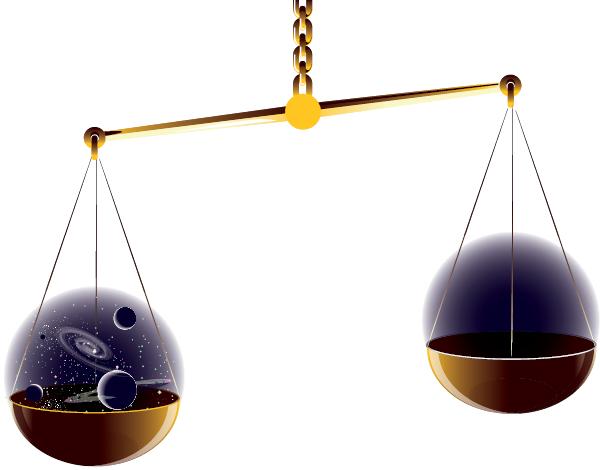Our universe survived thanks to the lack of symmetry - 10 billion and one matter particles against 10 billion antimatter particles. The matter and antimatter ionized itself, and the few remaining particles make up today's universe.

Experiments conducted in recent years have proven the separate predictions of Yoichiro Nambo from the Fermi Institute at the University of Chicago in the US, who won half of the 2008 Nobel Prize in Physics, for discovering the mechanism of spontaneous symmetry breaking in subatomic physics, and Maktoto Kubuyashi from the Center for High Energy Acceleration Research (KEK) in Japan and Toshihide Masakawa of the Yukawa Institute for Theoretical Physics at Kyoto University in Japan for discovering the source of the broken symmetry that predicts the existence of at least three families of quarks in nature.
The fact that our world oscillates perfectly symmetrically is due to a deviation from symmetry at the microscopic level. In the early sixties of the 20th century, Yoichiro Nambo formulated the mathematical description of spontaneous symmetry breaking in elementary particle physics. Spontaneous breaking of the symmetry hides the secret of nature under a surface that looks confused. The breaking of the symmetry proved to be extremely useful, and Nambo's theories penetrated the standard model of elementary particle physics. The model unites the smallest building blocks of all matter and three of the four forces in nature into one theory.
The breaking of symmetries that Nambu studied is different from the breaking of symmetries described by Makoto Kobayashi and Toshihide Maskawa. It seems that these spontaneous breaks have been occurring in nature since the beginning of the universe and this came as a complete surprise when they also appeared in particle physics experiments in 1964. Only in recent years have scientists been able to fully confirm the explanations that the two reached in 1972. For this work they are now awarded the Nobel Prize in Physics. They explained the symmetry breaking within the framework of the standard model but demanded that the model be expanded to include three families of quarks. These hypnotic new quarks have recently appeared in physics experiments. In 2001, they were discovered by two particle detectors - BaBar in Stanford, USA and Belle in Tacoma, Penn. The two broken symmetries were discovered separately from each other. The results were exactly as Kobayashi and Maskawa had predicted almost thirty years earlier.
Until now, the same kind of inexplicable symmetry breaking was behind the origin of the universe in the Big Bang about 14 billion years ago. If a similar amount of matter and antimatter were created, they would have to annihilate each other. But this did not happen, there is a tiny variation that allows one particle of extra matter for every 10 billion particles of antimatter. Thanks to this broken symmetry our universe survived. The question of how exactly this happened still remains unsolved. It is possible that the particle accelerator LHC - the Large Hadron Collider at CERN in Geneva will reveal some of the mysteries that continue to deceive us.

11 תגובות
Michael, my question was, who determined that background radiation was created precisely from this specific process of matter and antimatter. And does it work out quantitatively?
What Stress!
When is the next chapter of CERN?
Michael. You're right, sorry. I should have explained that I meant to point to one of the first discoveries of the background radiation. T.L.H.
point:
All the radiation left from the big bang is the background radiation.
The article Isaiah pointed to does not talk about matter and antimatter and is therefore not directly relevant, but since radiation is created by the interaction of matter and antimatter particles, then this radiation, like any other radiation, was indeed stretched with the expansion of the universe and, like it, it manifests itself in the background radiation.
For 4 (dot), what, it's a real antique:
http://prola.aps.org/pdf/PRL/v9/i11/p439_1
The really interesting questions are still open.
1. What is the origin of symmetry in nature in general micro and macro
2. Does the breaking of the symmetry merge with the quantum uncertainty property and what is the origin, for example, how can one understand the spontaneous collapse of the symmetric wave state within a certain radioactive atom and the discharge of particles.
Would it be possible for each particle to receive energy equal to 20 billion pure energy itself?
That sounds too much.
Isaiah, who told you this is what happened?
Answer to the point: It was stretched to the limit across the expanding universe and now its remains are nothing more than cosmic background radiation that prevents you from receiving Channel 7 on the radio. What a shame.
So where did all that tremendous radiation from ionization go? Does it fit in with what we see today?
"How good are your works, O Lord, how profound are your thoughts."